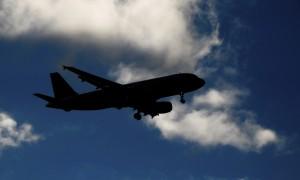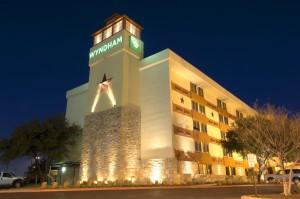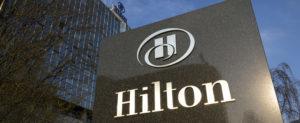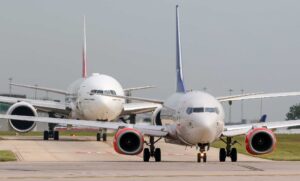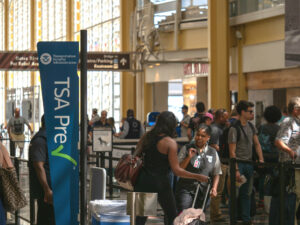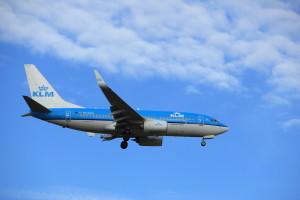Air Canada to Acquire 30 ES-30 Electric Regional Aircraft from Heart Aerospace
#1
Original Poster
Join Date: Aug 2014
Location: YQB
Programs: AC SE
Posts: 2,139
Air Canada to Acquire 30 ES-30 Electric Regional Aircraft from Heart Aerospace
Looks like AC is going electric.
https://media.aircanada.com/2022-09-...eart-Aerospace
https://media.aircanada.com/2022-09-...eart-Aerospace
Air Canada today announced a purchase agreement for 30 ES-30 electric-hybrid aircraft under development by Heart Aerospace of Sweden. The revolutionary regional aircraft, expected to enter service in 2028, will generate zero emissions flying on battery power and yield significant operational savings and benefits. Under the agreement, Air Canada has also acquired a US$5 million equity stake in Heart Aerospace.
#2
Moderator, Air Canada; FlyerTalk Evangelist
Join Date: Feb 2015
Location: YYC
Programs: AC SE MM, FB Plat, WS Plat, BA Silver, DL GM, Marriott Plat, Hilton Gold, Accor Silver
Posts: 16,775
Bizarre. At 200 km range on batteries, it's pretty much just good for the YVR-Vancouver Island routes. Or they'll be burning a bunch of fuel inefficiently to fly a little farther.
AC has also gotten completely out of the <50-seat market in recent years, and significantly cut back on 50-seat aircraft. So a 30-seater is an odd fit.
I'm very interested to see what the total CO2 emissions will look like when including the emissions from generating the power. It's all well and good for AC to say the plane itself doesn't generate any emissions, which is technically true, but electricity is not emissions-free.
I wonder how much of this purchase will be paid for out of the PR budget vs truly being an economic aircraft to operate.
AC has also gotten completely out of the <50-seat market in recent years, and significantly cut back on 50-seat aircraft. So a 30-seater is an odd fit.
I'm very interested to see what the total CO2 emissions will look like when including the emissions from generating the power. It's all well and good for AC to say the plane itself doesn't generate any emissions, which is technically true, but electricity is not emissions-free.
I wonder how much of this purchase will be paid for out of the PR budget vs truly being an economic aircraft to operate.
#3
Join Date: May 2015
Location: EXT, sometimes NYC/LON/YQT
Programs: Aeroplan, SPG/Marriott, Radisson Rewards
Posts: 774
#5
Join Date: Jun 2016
Programs: air miles
Posts: 283
This aircraft would seem better suited for the AC Express regional fleet. I'm not aware but is aircraft acquisition different for AC Express vs mainline AC?
Also I see that AC has taken a $5million stake in the company so it may have be an investment component to it.
Also I see that AC has taken a $5million stake in the company so it may have be an investment component to it.
#6
Moderator, Air Canada; FlyerTalk Evangelist
Join Date: Feb 2015
Location: YYC
Programs: AC SE MM, FB Plat, WS Plat, BA Silver, DL GM, Marriott Plat, Hilton Gold, Accor Silver
Posts: 16,775
Likely to be the same with these.
#9
Suspended
Join Date: Feb 2022
Posts: 853
China opened a record amount of coal fired power generation capacity last year, and are on track to double that this.
The onus is on us in the West to do what we can to offset at least a tiny fraction of that massive new CO output, regardless of cost or practicalities.
#10
Join Date: Dec 2010
Location: YYC
Programs: AC SE
Posts: 317
Bizarre. At 200 km range on batteries, it's pretty much just good for the YVR-Vancouver Island routes. Or they'll be burning a bunch of fuel inefficiently to fly a little farther.
AC has also gotten completely out of the <50-seat market in recent years, and significantly cut back on 50-seat aircraft. So a 30-seater is an odd fit.
I'm very interested to see what the total CO2 emissions will look like when including the emissions from generating the power. It's all well and good for AC to say the plane itself doesn't generate any emissions, which is technically true, but electricity is not emissions-free.
I wonder how much of this purchase will be paid for out of the PR budget vs truly being an economic aircraft to operate.
AC has also gotten completely out of the <50-seat market in recent years, and significantly cut back on 50-seat aircraft. So a 30-seater is an odd fit.
I'm very interested to see what the total CO2 emissions will look like when including the emissions from generating the power. It's all well and good for AC to say the plane itself doesn't generate any emissions, which is technically true, but electricity is not emissions-free.
I wonder how much of this purchase will be paid for out of the PR budget vs truly being an economic aircraft to operate.
From ES-30 | Heart Aerospace (so, you know, completely unbiased
 ) emissions reductions are "over 50% reduction per seat compared to 50-seats turboprops on longer sectors". Canada's electricity emissions intensity is far lower than global averages, particularly in QC and BC, but even in AB there should be substantial emissions reductions on e.g. YEG-YYC
) emissions reductions are "over 50% reduction per seat compared to 50-seats turboprops on longer sectors". Canada's electricity emissions intensity is far lower than global averages, particularly in QC and BC, but even in AB there should be substantial emissions reductions on e.g. YEG-YYCAs for being "economic" I think it depends how you measure it - let me know when someone figures out accurate 6 yr fuel vs electricity forecasts. But I know an increasing number of people who are reducing their flying because of CO2 concerns (even though fuel use in litres/100km per seat flying is lower than 1 person driving alone)
#11
Join Date: Dec 2010
Location: YYC
Programs: AC SE
Posts: 317
It's not really relevant.
China opened a record amount of coal fired power generation capacity last year, and are on track to double that this.
The onus is on us in the West to do what we can to offset at least a tiny fraction of that massive new CO output, regardless of cost or practicalities.
China opened a record amount of coal fired power generation capacity last year, and are on track to double that this.
The onus is on us in the West to do what we can to offset at least a tiny fraction of that massive new CO output, regardless of cost or practicalities.
China also installed more wind generation than the rest of the world combined in 2021, and in August 2022, over 30% of all new vehicle sales were NEV...
#12
Suspended
Join Date: Feb 2022
Posts: 853
From ES-30 | Heart Aerospace (so, you know, completely unbiased  ) emissions reductions are "over 50% reduction per seat compared to 50-seats turboprops on longer sectors". Canada's electricity emissions intensity is far lower than global averages, particularly in QC and BC, but even in AB there should be substantial emissions reductions on e.g. YEG-YYC
) emissions reductions are "over 50% reduction per seat compared to 50-seats turboprops on longer sectors". Canada's electricity emissions intensity is far lower than global averages, particularly in QC and BC, but even in AB there should be substantial emissions reductions on e.g. YEG-YYC
As for being "economic" I think it depends how you measure it - let me know when someone figures out accurate 6 yr fuel vs electricity forecasts. But I know an increasing number of people who are reducing their flying because of CO2 concerns (even though fuel use in litres/100km per seat flying is lower than 1 person driving alone)
 ) emissions reductions are "over 50% reduction per seat compared to 50-seats turboprops on longer sectors". Canada's electricity emissions intensity is far lower than global averages, particularly in QC and BC, but even in AB there should be substantial emissions reductions on e.g. YEG-YYC
) emissions reductions are "over 50% reduction per seat compared to 50-seats turboprops on longer sectors". Canada's electricity emissions intensity is far lower than global averages, particularly in QC and BC, but even in AB there should be substantial emissions reductions on e.g. YEG-YYCAs for being "economic" I think it depends how you measure it - let me know when someone figures out accurate 6 yr fuel vs electricity forecasts. But I know an increasing number of people who are reducing their flying because of CO2 concerns (even though fuel use in litres/100km per seat flying is lower than 1 person driving alone)
#13
Join Date: Feb 2018
Location: YYT
Programs: M-Bonvoy Platinum Elite, Aeroplan 50K, DragonPass, AMEX MR, NEXUS
Posts: 1,715
Definitely not going to be feasible on most of the short AC Express routes (save for Vancouver Island, some parts of Ontario, etc.) unless TC amends the fuel reserve requirements in the CARs (Canadian Aviation Regulations).
As an example, the other day, a DH4 flying YHZ-YYT was unable to land in YYT so went all the way back to YHZ. The ability to return to the origin airport will not be possible on many routes that this plane could fly.
As an example, the other day, a DH4 flying YHZ-YYT was unable to land in YYT so went all the way back to YHZ. The ability to return to the origin airport will not be possible on many routes that this plane could fly.
#14
Formerly doc4science
Join Date: Sep 2019
Location: CMH/DSM
Programs: United Airlines Silver, Hilton Diamond, Marriott Gold
Posts: 562
Bizarre. At 200 km range on batteries, it's pretty much just good for the YVR-Vancouver Island routes. Or they'll be burning a bunch of fuel inefficiently to fly a little farther.
AC has also gotten completely out of the <50-seat market in recent years, and significantly cut back on 50-seat aircraft. So a 30-seater is an odd fit.
I'm very interested to see what the total CO2 emissions will look like when including the emissions from generating the power. It's all well and good for AC to say the plane itself doesn't generate any emissions, which is technically true, but electricity is not emissions-free.
I wonder how much of this purchase will be paid for out of the PR budget vs truly being an economic aircraft to operate.
AC has also gotten completely out of the <50-seat market in recent years, and significantly cut back on 50-seat aircraft. So a 30-seater is an odd fit.
I'm very interested to see what the total CO2 emissions will look like when including the emissions from generating the power. It's all well and good for AC to say the plane itself doesn't generate any emissions, which is technically true, but electricity is not emissions-free.
I wonder how much of this purchase will be paid for out of the PR budget vs truly being an economic aircraft to operate.
#15
Join Date: Sep 2014
Location: YEG
Programs: Table scraps from Aeroplan and AmEx Plat
Posts: 901
It's not really relevant.
China opened a record amount of coal fired power generation capacity last year, and are on track to double that this.
The onus is on us in the West to do what we can to offset at least a tiny fraction of that massive new CO output, regardless of cost or practicalities.
China opened a record amount of coal fired power generation capacity last year, and are on track to double that this.
The onus is on us in the West to do what we can to offset at least a tiny fraction of that massive new CO output, regardless of cost or practicalities.
You want to live in a yurt and cuddle with your goat to keep warm in January (what it would really take to meet federal carbon goals), knock yourself out.
Me? I'm here for the party!
This plane will be 10 times more useless than a Nissan Leaf.
But .. ESG.


